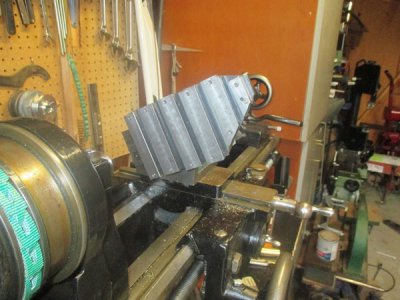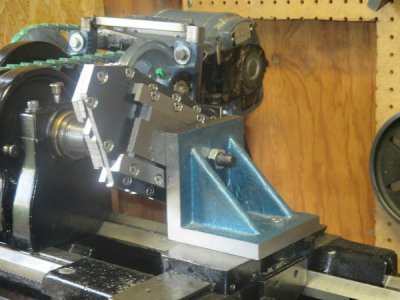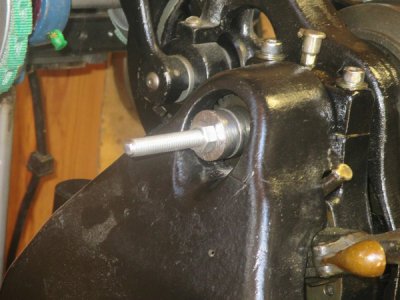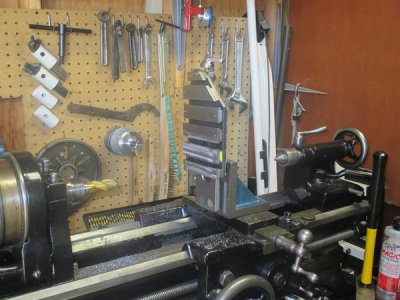- Joined
- Dec 6, 2015
- Messages
- 807
Welp, I had a few minutes to spend out in the shop, so I thought I'd finish the milling attachment. I went through the old "L. C. Mason" article that was posted to Vintage Projects (http://www.vintageprojects.com/machine-shop/lathe-milling-attach-plans.pdf). The original plans were for a 7" to 8: lathe, but my South Bend Junior is a 9". The instructions do mention "scaling it up" for a 9" to 10" lathe, so I thought I'd take a whack at it :


Of course, with the 3MT spindle taper and a short lathe bed, I needed some end mill collets that would fit the taper inside, without using a collet chuck. I found a set of 3MT collets that used a 3/8-16 threaded rod, so I ordered those and some end mills. I ran to Home Depot and bought a two-foot chunk of threaded rod to match. However, I needed a way to hold it on the other end (gear end of the spindle). I had a chunk of 1" round stock sitting from the build for the milling attachment project. I chucked that up in the 4-jaw chuck, drilled a tight hole through the center (for the threaded rod), and put a bevel (a 45 degree bevel) on one end, just long enough to self-center in the spindle through hole. I turned it round, and then I cut it off flat. It was PERFECT for holding those collets into that taper :

There is one issue, though - it likes to come loose. I think I need to put a burr on that threaded rod to prevent the nut from releasing.
Next, I started to finish the milling attachment by milling the face of the table. I got the two bottom surfaces complete before I ran into an issue :

The issue here is that it wouldn't go low enough to mill all of the surfaces. Also, I had built the face all the way up, without realizing I'd never be able to mill that high. The efforts were pretty pointless for that. The scaling was basically done wrong.
If I were to do it over, I'd only scale the bottom area (where the milling surface is stacked), and leave the top angle area alone. Then, you simply lengthen the threaded feed screw (on the bottom side), and the ways you build (in the guide, parts F, G, H, and J). I'd also do it myself, as the t-slots didn't line up right - but the neighborhood kids are now interested in making things (3D printers and metal work), so my job there is done.


Of course, with the 3MT spindle taper and a short lathe bed, I needed some end mill collets that would fit the taper inside, without using a collet chuck. I found a set of 3MT collets that used a 3/8-16 threaded rod, so I ordered those and some end mills. I ran to Home Depot and bought a two-foot chunk of threaded rod to match. However, I needed a way to hold it on the other end (gear end of the spindle). I had a chunk of 1" round stock sitting from the build for the milling attachment project. I chucked that up in the 4-jaw chuck, drilled a tight hole through the center (for the threaded rod), and put a bevel (a 45 degree bevel) on one end, just long enough to self-center in the spindle through hole. I turned it round, and then I cut it off flat. It was PERFECT for holding those collets into that taper :

There is one issue, though - it likes to come loose. I think I need to put a burr on that threaded rod to prevent the nut from releasing.
Next, I started to finish the milling attachment by milling the face of the table. I got the two bottom surfaces complete before I ran into an issue :

The issue here is that it wouldn't go low enough to mill all of the surfaces. Also, I had built the face all the way up, without realizing I'd never be able to mill that high. The efforts were pretty pointless for that. The scaling was basically done wrong.
If I were to do it over, I'd only scale the bottom area (where the milling surface is stacked), and leave the top angle area alone. Then, you simply lengthen the threaded feed screw (on the bottom side), and the ways you build (in the guide, parts F, G, H, and J). I'd also do it myself, as the t-slots didn't line up right - but the neighborhood kids are now interested in making things (3D printers and metal work), so my job there is done.

